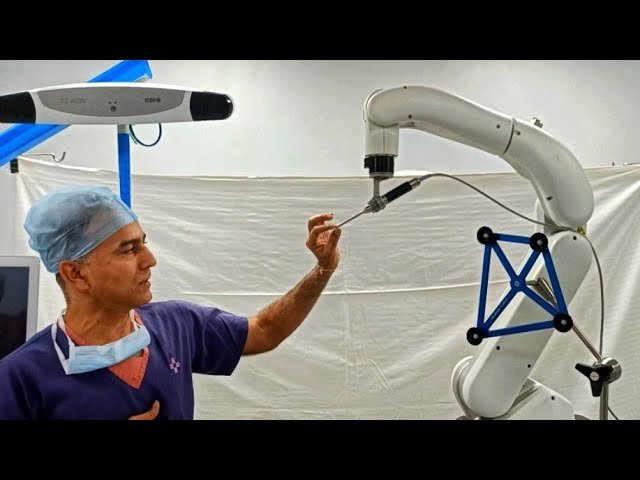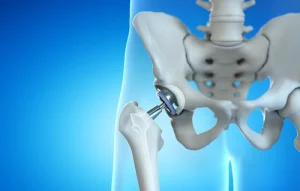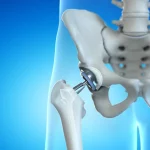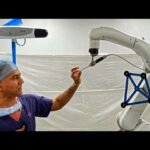In accordance with the insights provided by Dr. Ashwani Maichand, we are pleased to introduce a revolutionary addition to our medical team – a cutting-edge robotic system meticulously designed for advanced joint replacement procedures, specifically catering to robotic knee and hip replacements. Dr. Ashwani Maichand brings to the forefront our longstanding success in delivering exceptional outcomes through the application of minimally invasive surgical (MIS) techniques.
The core objective behind the integration of robotic technology is to address the critical nuances of implant positioning and bone cuts. Despite the proficiency attained through surgical expertise, the persisting factor of human error poses potential implications for the implant’s longevity and overall performance. In a strategic move to eliminate this concern, Dr. Ashwani Maichand has ushered in a state-of-the-art robotic system.
Distinguished by its unparalleled precision, this robotic system achieves up to 1mm accuracy. By inputting comprehensive images of the patient’s bone structure, the robotic system seamlessly translates this data into precise surgical actions. This ensures optimal results for knee replacement procedures, where the positioning of femur and tibial implants, as well as the chosen angles, significantly influence both short-term and long-term outcomes.
The eradication of human error stands as a pivotal advantage offered by this robotic system. While manual assessments may introduce variability, the automated precision of the robot guarantees error-free implant positioning. Dr. Ashwani Maichand’s commitment extends beyond surgical expertise alone; the approach combines the proficiency of MIS techniques with robotic precision, providing patients with a comprehensive solution that yields benefits in both the immediate and extended postoperative periods.
The workflow involves inputting patient-specific bone structure information, which is then seamlessly displayed on a connected screen. The system comprises a robotic arm and a burr responsible for bone cutting. Importantly, the burr autonomously determines the cutting angle based on the patient’s unique bone structure and deformities.
Distinguishing itself as the world’s first fully active robot, this system surpasses previous semi-active robotic models. Unlike prior iterations that required surgeon intervention, Dr. Ashwani Maichand’s fully automatic robot performs precise cuts without manual input, enhancing efficiency and minimizing the potential for variability in surgical outcomes.
This groundbreaking technology represents a significant leap forward in facilitating our patients, ensuring unparalleled accuracy and reliability in joint replacement surgeries. Under the guidance of Dr. Ashwani Maichand, we take pride in presenting this world-first fully automatic robot as a testament to our commitment to advancing patient care through cutting-edge medical innovations.
Preparations for surgery
As the patient undergoes preparations, on the other side, the surgical team is engaged in the meticulous calibration of the robotic system for a right-side knee replacement. This critical step involves a thorough examination of the robot’s movements to ensure optimal functionality before the commencement of the surgery.
The robotic arm, possessing a remarkable range of motion, undergoes a comprehensive check of its capabilities. Its capacity to maneuver in all directions is a distinctive feature, surpassing the limitations of human hands. To maintain a sterile environment and safeguard the patient from exposure to any non-sterile elements, the robotic arm is meticulously covered with a sterile plastic sheet.
The versatility and extended reach of the robotic arm are particularly noteworthy. Capable of navigating in directions impractical for human hands, its coordination is facilitated through a camera system. This integration allows the surgical team to visualize and monitor the actions of the robotic arm in real-time, ensuring precision throughout the procedure.
The synergy between two interconnected machines—the robotic system and the patient—becomes apparent as the surgical team readies for the next phase. The robot, linked to a specialized frame, offers the flexibility to adjust the knee’s angle and securely fix it in the desired position. This intricate coordination, facilitated by advanced technology, sets the stage for a sophisticated and precise knee replacement procedure, aligning with our commitment to providing patients with state-of-the-art surgical interventions.
Benefits of Minimally Invasive Robotic Knee Replacement:
1) Improved Patient Comfort Following Surgery:
Patients’ postoperative pain is significantly reduced with robotic-assisted Minimally Invasive Knee Replacement (MIS), which is one of its main benefits. Robotic technology’s precision makes it possible to perform surgery with as little disruption to the surrounding muscles, nerves, and tissues as possible. For those having knee replacement surgery, this results in a more comfortable postoperative period and a more efficient healing process.
2) Decreased Infection Risk, Extended Implant Life:
Robotic MIS knee replacement treatments significantly lower the risk of infections following surgery. Robotic systems’ accuracy and precision limit the amount of tissue damage and there is no human touch on bone throughout the procedure and lower the risk of complications. A decreased chance of infection results in a longer knee implant lifespan, which eventually improves the prosthesis’s overall toughness and functionality.
3) Multifaceted Benefits Beyond Implant Positioning:
Although it’s a popular belief that robotic surgery is primarily used to guarantee precise implant placement, the benefits go well beyond this. A comprehensive approach to knee replacement surgery is made possible by robotic technology. It enables accurate bone cut execution, ideal implant positioning, and rigorous preoperative planning based on the individual anatomy of the patient. Better overall results, such as increased joint function and longevity, are a result of this holistic approach.
The trend in knee replacement surgery toward MIS methods and robotic surgeries is a reflection of technological advances that not only expedite the surgical procedure but also greatly enhance the patient experience. As we move from conventional techniques to these cutting-edge methods, patients can anticipate less discomfort, a decreased risk of infection, and a better knee implant long-term result.
4) Led Safety:
Myth1:
Computer errors are a common problem in robotic joint replacement surgeries.
Fact1:
It is called robotic-assisted knee replacement because the surgeon works alongside the robot. Always held by the surgeon is the robotic arm. The surgeon can avoid unintentionally harming nerves, vessels, or important soft tissue structures by using the haptic boundary, a virtual boundary that the robot offers.
Myth2:
A robotic knee replacement may not be an option for me.
Fact2:
Patients who meet the requirements for traditional knee replacement surgery can also undergo robotic knee replacement surgery. The lack of jigs during robotic knee replacement surgery significantly lowers the risk of medical complications in elderly patients.
For More Information contact: Dr.Ashwani Maichand
Frequently Asked Questions (FAQ)
Who should perform the surgery?
Robotic surgery is a skill-and experience-driven field. The procedure is carried out at the Specialist Hospital by highly skilled surgeon Dr. Ashwani Maichand. Experts like Dr. Ashwani, who has decades of experience handling intricate and difficult surgeries, ought to be in charge of any surgery. Definitely get professional assistance if you’re thinking about having knee replacement surgery.
Is a quicker recovery guaranteed by robotic surgery?
Yes, Robotic surgery ensures a quicker recuperation, a shorter hospital stay, and a quicker return to regular activities and employment.
Are the results long-term and safe?
Yes, Considered one of the safest options, particularly when compared to surgical procedures, are robotic surgeries. Additionally, it offers less chance of infection, radiation exposure, and tissue damage.
Is the cost of robotic total knee replacement surgery higher than that of conventional surgery?
Because robotic technology is used, total knee replacement surgery may come with additional costs. The exact healthcare facility, insurance coverage, and unique circumstances can all affect the final cost. It is best to discuss the financial aspects of the procedure with your insurance company and surgeon.







Knowledgeable Information.
Great share!” Thanks for sharing these kind of information with us.